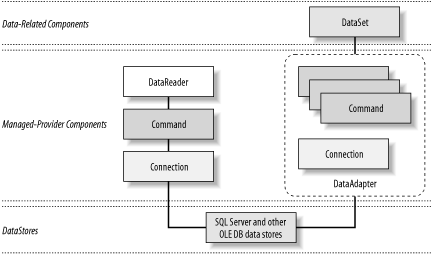5.1 ADO.NET Architecture
Microsoft ADO.NET's object model encompasses two distinct groups of classes: content components and data-provider components.[1] The content components include the DataSet class and other supporting classes, such as DataTable, DataRow, DataColumn, and DataRelation. These classes contain the actual content of a data exchange. The data-provider components assist in data retrievals and updates. Developers can use the connection, command, and data reader objects to directly manipulate data. In more typical scenarios, developers use the DataAdapter class as the conduit to move data between the data store and the content components. The data can be actual rows from a database or any other form of data, such as an XML file or an Excel spreadsheet.
[1] In previous releases of this book, we referred to the Data-Provider components as managed-provider components.
Figure 5-1 shows the high-level architecture of ADO.NET. ADO developers should have no problems understanding connection and command objects. We offer a brief overview then go into more detail in the rest of this chapter.
Figure 5-1. High-level architecture of ADO.NET

A data reader is a new object providing fast, forward-only, and read-only access to data. This structure is similar to an ADO Recordset, which has server-side, forward-only, and read-only cursor types.
The DataSet class is analogous to a lightweight cache of a subset of the database from the data store for disconnected operations. It also allows reading and writing of data and schema in XML, and it is tightly integrated with XmlDataDocument, as you will see later.
The DataAdapter class serves as a higher-level abstraction of the connection and command classes. It enables you to load content from a data store into a DataSet and reconcile DataSet changes back to the data store.







